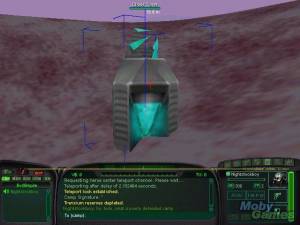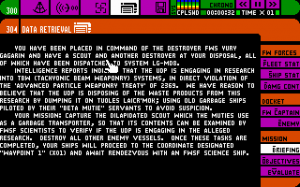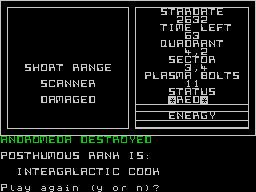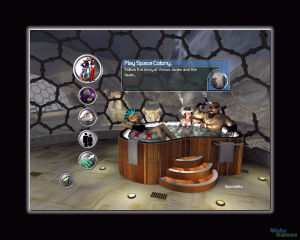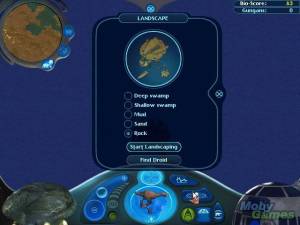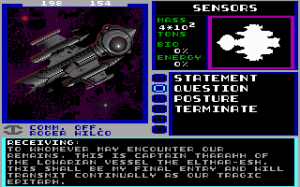Game Classification
Universe II Omnitrend Software, Omnitrend Software, 1986
Classification
VIDEO GAMEKeywords
Market
This title is used by the following domains:- Entertainment
Audience
This title targets the following audience:Age : 12 to 16 years old / 17 to 25 years old
General Public
Gameplay
The gameplay of this title is Game-based(designed with stated goals)
The core of gameplay is defined by the rules below:
Similar games
 Universe II is the sequel to Omnitrend's highly complex space simulation Universe. It takes place 20 years after the original game. A second hyperspace booster has been found, so there is hope that communication with Earth will be re-established in the foreseeable future. Still, the situation in the Local Group is tense. Two rival governments have formed: The Federated Worlds and the United Democratic Planets. Currently, travel and trade between the two is ongoing, but everyone fears the tensions will lead to all-out war.
Universe II is the sequel to Omnitrend's highly complex space simulation Universe. It takes place 20 years after the original game. A second hyperspace booster has been found, so there is hope that communication with Earth will be re-established in the foreseeable future. Still, the situation in the Local Group is tense. Two rival governments have formed: The Federated Worlds and the United Democratic Planets. Currently, travel and trade between the two is ongoing, but everyone fears the tensions will lead to all-out war.
The player takes the role of an undercover operative for the Federated Worlds. Disguised as a free trader from Vromus Prime, they will have to earn a living for themselves, because the FW only gives out money or equipment for special missions.
As in the original game, there are many ways of spending one's time and earning credits in the Local Cluster. Trade, exploration, passenger or freight transport, mining, smuggling, bounty hunting or piracy are among the many options.
Several different ships are available for purchase, each suited to different tasks. Some may have more room for mining equipment or cargo, others for weapons systems. Ships are highly customizable, with dozens of different models available for the likes of FTL and sub-light drives, energy converters, bridge and crew modules, computers, medical and communications systems, life support, scanners and more. Each part varies in damage it can take, size required for installing, visibility factor (highly visible parts are more likely to be hit in an attack) and sophistication (highly sophisticated parts can only be serviced and repaired in special drydocks).
A ship also requires a crew, and this is one area where Universe II differs from its predecessor: crew management is now much more complex, and comparable to a role-playing game. Crew members have one of seven specialties: captain, astrogator, gunner, pilot, miner, marine and engineer. Specialists are required for most tasks - without a miner mining is impossible, marines are required for man-to-man combat, only engineers can repair the ship's systems, et cetera. Crew members gain experience automatically with time, but can also be trained at a technical school in exchange for the right number of credits. They must also be fed, paid and require sleep. Their salary increases with experience. If there is no pay day for a while, they leave, whereas a lack of provisions naturally leads to starvation. The sleep requirements are simulated by assigning crew members to a watch cycle. A process called asomnigenation can eliminate the need for sleep in astrogators and gunners.
Another difference from the original game is a more detailed simulation of combat: when boarding an enemy ship, the player's marines must now capture the bridge by either killing all enemy marines or capturing 30% of the control panels. When deploying assault capsules to mine from an unwilling planet, any defense stations must be destroyed first. These combat engagements take place on special tactical screens.
Another new feature comes into play when docking at a starport: these sections are played in the manner of text adventures, utilizing a text parser. The bases can be freely explored, characters can be talked to, and valuable items and clues be found.
Universe II does away with the text-based interface of the original game, and (other for the text adventure parts) uses a menu-based window system not unlike the contemporary GEM or Macintosh interfaces. [source:mobygames]
Distribution : Retail - Commercial
Platform(s) : Apple II - Atari ST - PC (Dos) - Macintosh
 Français
Français English
English







